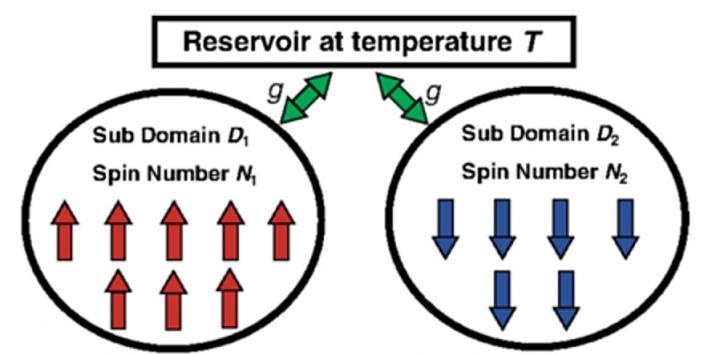Apr 19 2018
Scientists from the National Institute of Informatics (NII) in Tokyo and NTT Basic Research Laboratories (BRL, Nippon Telegraph and Telephone Corporation) in Japan have reported an explanation of how quantum systems could be able to heat up by cooling down.
 The image above shows the counter-intuitive behavior of a double spin subdomain system coupled to a single reservoir. (Image credit: Physical Review Letters)
The image above shows the counter-intuitive behavior of a double spin subdomain system coupled to a single reservoir. (Image credit: Physical Review Letters)
Their research paper has been featured in Physical Review Letters (February 2018 issue).
"Heating by cooling sounds rather counter-intuitive, but if the system has symmetries, decay could mean many things," says Kae Nemoto, a Professor in the Principles of Informatics Research Division at NII which is part of the Inter-University Research Institute Corporation Research Organization of Information and Systems (ROIS).
Nemoto and her team studied a double sub-domain system coupled to a single constant temperature reservoir. Each sub-domain had several spins--a form of angular momentum carried by elementary particles such as nuclei and electrons. The scientists looked at the situation where the spins within each sub-domain are aligned in relation to each other but the sub-domains themselves are oppositely aligned (for example, all up in one and all down in the second). This forms a definite symmetry in the system.
As time goes on, the components of the subdomain decay in a process known as relaxation.
Usually, we expect both domains to decay to the reservoir temperature; however, when the two domains coupled with a reservoir maintain a certain symmetry, the decay process can apparently heat the smaller domain up, even beyond the high temperature limit.
Kae Nemoto
The researchers can regulate the domains to a certain extent, while the reservoir is really a much larger, unidentified entity that can be characterized using macroscopic parameters, such as temperature. They use this system to envisage new dynamics and explore the numerous levels of thermalization, such as the decay in one subdomain exciting the components of another subdomain.
"Cooling processes can now heat a subsystem up," Nemoto said. "Our case is mathematically rather simple, but it indicates the rich dynamics caused by quantum dissipative processes."
As not all systems possess symmetry, Nemoto and her team would like to further study the multifaceted interactions between the subdomains and reservoir. "We will investigate more of these counter-intuitive decay dynamics and show when and how exactly we can see these dynamics," Nemoto said, observing that these effects could be used to design and regulate quantum systems.
The team for this research included Yusuke Hama, a postdoctoral research fellow at NII, William Munro, a senior distinguished scientist at NTT Basic Research Laboratories (also a visiting professor at NII) and Kae Nemoto. This research was supported partially by Japan's Ministry of Education, Culture, Sports, Science, and Technology, as well as Japan's Society for the Promotion of Science.